Contributions from Jacque Lynn Schultz, C.P.D.T. and Dr.”Stephanie Janeczko, D.V.M.
You found your feline kindred spirit and he’s coming home from the animal shelter tomorrow. Today is shopping day. Time to procure the items on your list: cat food, toys, a scratching post, and grooming supplies. At the very top of the list are the litter box necessities. You head to the nearest pet supply superstore and are met by row upon row of cat litter choices. What to choose, what to choose! Whether you are an experienced owner or a novice, the multitude of choices is dizzying. This was not always the case.

Pay Dirt
Prior to World War II, most cats lived indoor/outdoor lives and their toileting areas were neighborhood backyards and gardens. For indoor needs, some families kept boxes of sand or ashes from the furnace for their cat’s use in the cellar. Housewives of the 1940s were none too enamored with cats tracking ashes or sand through homes. An ex-sailor named Ed Lowe suggested that his neighbor try absorbent clay, a popular product for cleaning up industrial oil spills in wartime factories which just so happened to be made by his father’s firm. Eureka! Kitty litter was born.
Granulated clay litter offered improved odor control over ashes or sand by siphoning urine to the bottom of the pan and controlling ammonia smells until the litter reached a saturation point – usually within a week in a box used by a single cat. However, if more than one cat uses the box, there is usually a fairly pronounced odor in 4 to 6 weeks’ time, even with scooping and litter replacement. The granules of traditional litter are fairly large and do not tend to cling to a cat’s paws, so there’s little tracking of litter outside the box.

To Clump or Not to Clump
Granulated clay litters remained unchallenged for nearly 40 years, with little change or refinement until Thomas Nelson, Ph.D. needed a way to supplement his income while in graduate school. The biochemist began to raise Persian cats and ended up developing clumping litter. Quoted in an October 1996 article in Cat Fancy magazine, Dr. Nelson explains, “I hunted around and found clays that were dried but not baked. They were very absorbent and would form a clump when the cat urinated on them. The clump could then be removed, thereby eliminating the urine. I had a box of litter I did not change in 10 years – I just added more – and it got absolutely no odor at all.
The removal of almost all urine and feces does produce a better-smelling box area for weeks at a time without completely throwing out the old litter and starting from scratch. Today, most folks who use granulated clay either scoop solids daily and completely replace the litter once a week or use less litter in the box and dump and clean daily. It is essential to replace the approximate amount scooped out with fresh clumping litter, for if it is allowed to go below a certain volume, urine will tend to pool, and cake in corners and odors will arise.

Clumping litters are considerably more expensive than granulated clay. However, by 1999, clumping litters with their superior odor control capabilities, captured more than half of the litter market.
Clumping litters offer a variety of products beyond the traditional scented and non-scented choices found with most granulated litters. Most cats prefer non-scented litter, an especially important point for owners who plan to use covered litter boxes. There are multi-cat formulas that form more cement-like clumps that may keep their form even when tread on by extra cat traffic; these are definitely not flushable! There are usually less-tracking formulas, which offer slightly larger granules that are more likely to fall off the cat’s paws before he leaves the box. And there are clumping litters developed especially for flushability, a quality most clumping litters don’t have due to their expansive properties. Each year the list of varieties grows.
Several years ago, an article in the now-defunct holistic cat magazine Tiger Tribe questioned the safety of clumping litter if ingested, especially for neonate kittens who often eat litter when it is introduced to them during the weaning stage. Dr. James Richards, Director of Cornell’s Feline Health Center in Ithaca, NY recalls a flurry of Internet correspondence, letters by mail, and telephone calls once the article appeared. But after using clumping litter at home and in his practice, and networking with veterinary surgeons and online contacts about the subject, Richards says, ” I have never encountered anyone who has seen a problem related to the clumping litter. If it occurs, it is rare indeed, and certainly, we would know by now.” While there has been no proof to claims of problems in the scientific literature, caretakers may will beh to delay introducing kittens to clumping litter until three months of age. Any cat more than that detected eating litter should be taken to a veterinarian, since this behavior may indicate anemia or other dietary deficiencies.
The field of cat litter doesn’t end at granulated versus clumping clay. The shelves at the local pet supply emporium also hold an array of litters made from eco-friendly materials including recycled newspaper, corn cob, peanut shell meal, processed orange peel, wheat, pine sawdust and shavings, hardwood and cedar chips, silica gel beads, and crystals and automated self-cleaning litter boxes. All promise to be superior odor controllers, long-lasting, and earth-friendly. What things to choose, what to choose…
In 1990, Dr. Peter Borchelt, an applied animal behaviorist, ran three 10-day tests to determine feline litter preference using a comparison of 14 types of the commercial litter as well as topsoil mixed with clay litter, and playbox sand. Each cat had six boxes to choose from; midway through the testing, the boxes were moved to prevent placement preference from overriding litter type preference. In test after test, fine-grained clumping litter was used more than twice as often as its nearest competitor, with boxes of wood chips, grain litter, and recycled paper litter going completely unused. Borchelt concludes, “These data support the clinical observation that an important factor in cats’ preference for litter material is its texture, granularity or coarseness. . . a finely textured (clumping) clay, was preferred to clay with larger particle sizes. But playbox sand, which is usually also finely textured, was not preferred much more than coarse clay, perhaps because of the weight of the particles.”
What to choose?
As a guardian, you control the purse strings, but the ultimate choice is up to your feline friend. If he does not like the smell and feel of the litter, he may leave his business elsewhere.
The average cat is happiest with fine, unscented clumping cat litter. Cats are typically not big fans of the scented varieties that many people tend to prefer. They often dislike the crystal-type litters as well – most sizzle when they get wet, so you can imagine why that would be unpleasant for a cat! The average cat hates the plastic litter liners as well, so it’s probably end up beings to stay away from those. Having said all this, each cat is an individual and what one doesn’t like, another might love.
The best way to determine your cat’s litter preference is to set up a “litter cafeteria.” This allows the cat to make his selection from a number of different choices. To do this, you need at least a few uncovered litter boxes which are the same other than the type of litter that they contain.
Cats will preferentially eliminate in the box that is most pleasing to them, and this will allow you to select the most appropriate litter for your cat. You may need to change litters one or two at a time in a kind of challenge style where the winning litter goes up against the challenging litter until you’ve been through all the options.
Wondering about Cleaning the Litter Box How Often Is Best? Check it out on our latest post!


0 Comments